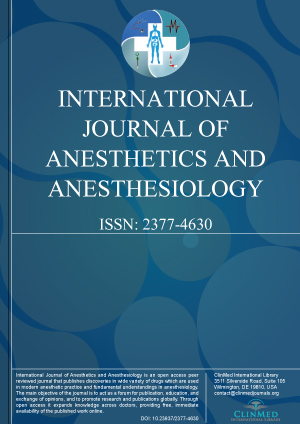Open Access DOI:10.23937/2377-4630/1410089
Inhalation Induction in Tracheostomized Patients: Comparison of Desflurane and Sevoflurane
Kerem Erkalp, MD, Nuran Kalekoglu Erkalp, MD, Veysel Erden, MD, Arzu Yasemin Korkut, MD, and Yesim Cokay Abut, MD
Article Type: Original Article | First Published: May 10, 2019
Inhalation induction (II) of anesthesia is a commonly used method in difficult airway management, pediatric anesthesia and also tracheostomized patients' surgical practices. Sevoflurane and desflurane are the most common inhalation agents for II in these procedures of patients. We demonstrated that II with sevoflurane or desflurane in tracheostomized patients who are not studied up until now and their outcomes. Cardiorespiratory changes in II should be the same in tracheostomized patients with d...
Open Access DOI:10.23937/2377-4630/1410088
Postoperative Analgesia after Combined Obturator Nerve and Adductor Canal Block in Total Knee Arthroplasty
Melike Seyda Dagdelen, Fatma Yesim Abut, Veysel Erden and Seda Seven
Article Type: Original Article | First Published: April 17, 2019
The purpose of this study was to evaluate adding an obturator nerve block to adductor canal block may reduce tramadol consumption (primary endpoint), improve pain relief, enhance early ambulation ability, and reduce side effects (secondary endpoints) after TKA compared with single adductor canal block. This study was carried out retrospectively in order to compare the effect of the single injection adductor nerve block, which was applied to the patients undergoing total knee arthroplasty (TKA) u...
Open Access DOI:10.23937/2377-4630/1410087
Spinal Anesthesia for Emergent Testicular Torsion Surgery in a Pediatric Patient with Spinal Muscular Atrophy Type-II
Hande Gurbuz Aytuluk and Hulya Topcu
Article Type: Case report | First Published: April 05, 2019
Spinal muscular atrophy (SMA) is one of the most common inherited diseases in children. The clinical symptoms of this neuromuscular disease vary widely from muscle weakness to death according to the onset of symptoms. There is no specific treatment for the disease. There are many risks for anesthesia, as these patients usually have skeletal deformities, increased sensitivity to opioids and neuromuscular blockers, and pulmonary disease secondary to respiratory muscle dysfunction. There is no evid...

